Executive Summary
The purpose of this essay is to organise a strategic plan for Al Rawabi Dairy farm through getting a clear overview of this company. To achieve this, the current paper will consider the history and development, vision, mission, and core business value of Al Rawabi. Moreover, this paper will focus on the external and internal environmental issues of Al Rawabi by carrying out PESTLE, Porter’s five forces, SWOT, and Value Chain analyses of the company. In addition, this essay will evaluate the generic and grand strategies, their implementation and control process, competitive position, and strategic objectives of Al Rawabi.
History and Development of Al Rawabi Dairy Company
Al Rawabi is the pioneer of ‘packaged dairy products’ industry, currently serving more than 40000 retail outlets all over the GCC (Gulf Cooperation Council) region. The company started its business in 1990 with a vision to establish itself in the market through fresh and distinctive products delivered without compromising the quality to sales’ levels. Within the first five years of its business commencement, the company expanded rapidly, and by the subsequent ten years, Al Rawabi became the business leader of the dairy products market in the UAE and other countries in the gulf area. The unique strength of the company is the high quality of its products, which is quite difficult to maintain in the GCC region due to excessive heat and specific weather conditions.
The weakness of the company is the high price of its products that negatively affects the sales volumes (Al Rawabi 2010). Under the current conditions, Al Rawabi fails to develop successfully in the global scope; one can conclude this from the company’s absence in the majority of the gulf region countries as well as some other countries of the world. Like many other industries, the dairy industry also faces the influence of the external environment in both positive and negative ways. At the same time, the rising demand for dairy products in the UAE market is another advantage of Al Rawabi.
There is strong competition in the dairy market as a number of local and international companies have entered it in the attempt to increase their market shares over the recent years. To protect its interests in such a fierce competition, Al Rawabi has developed some competition development strategies focused on maintaining high quality of products, providing customer care, giving feedback to the buyers, etc. The management of the company implemented the strategies for maintaining the quality of the workforce, ensuring proper strategic development, and controlling a uniform system for operation of Al Rawabi.
The Vision of Al Rawabi
A vision refers to a long-term goal of an organisation that it may want to achieve within the next ten to twenty years. As part of the organisation’s long-term planning, its vision is as a rule stated in one or two sentences. The vision of Al Rawabi is to become the UAE and GCC region market leader with its innovative dairy products, as well as to achieve high levels of customer satisfaction. Within the past 8 – 10 years, the company reportedly succeeded in achieving its vision by becoming a market leader in UAE and Oman.
Mission of Al Rawabi
A mission is a short-term goal of an organisation, which may be achievable within the next five years (Hill & Gareth 119). The current business strategies and objectives of an organisation are developed on the basis of its mission statement. The mission of Al Rawabi includes maintaining high quality and freshness of the products with minimum price, ensuring healthy relationship with the stakeholders, generating the best customer care policies, empowering employees, as well as using the most updated environment-friendly technology in its production process.
Core Business Value of Al Rawabi
The core business value of Al Rawabi consists of the following elements:
- Integrity: Honesty and integrity are the core values of Al Rawabi; the company strictly maintains these values in its competitive relations and customer-oriented policies;
- Leadership: Al Rawabi exercises the leadership that helps it integrate into the market and use all the systems, through which the organisation can achieve its clearly outlined goals.
- Innovation: Al Rawabi always strives to bring innovation in its production process as well as in the whole dairy market.
PESTLE Analysis of Dairy Industry in UAE
Political Factors
The dairy industry faces some pressure from the government to reduce the expenses incurred by the operation of cow farms, and one of the possible ways to do this is to increase the number of camel farms. The reason behind this pressure is that UNESCO presents a proposal to the UAE government, according to which the production of cow milk requires excessive use of air conditioning, water, and grass that is not available in UAE region. The problem is that such a situation influences the local ecosystem negatively and farming of the local cattle can help overcome this issue. However, the local government and banks are inclined to support domestically owned businesses;
Economic Factors
UAE is a country of strong economic growth where the per capita income amounts to $37,000 and the total GDP is $163 billion. Oil is the main base of the economy and almost 70% of the total GDP comes from this sector. The contribution of agriculture, including the dairy products, only covers 2% – 3% of the total GDP. Weather and other natural conditions make it difficult for the dairy industry to flourish in the country. It entails huge investment to run a dairy firm in UAE because of excessive heat and scarcity of water.
In 2001, to maintain the fair competition in the country within the framework of free trade area, the UAE government and business companies formed UAE Dairy and Juice Group, the union of dairy producers and the ministry of commerce that aims at protecting the former’s interest;
Social Factors
The Arab society tries to maintain its own traditions, culture, and values in every aspect of its existence, which has considerable influence upon Al Rawabi. The following aspects have both positive and negative impact on the company:
- In UAE, more than 96% people are Muslims;
- The dairy products are popular among both children and grown-ups;
- Al Rawabi has a wide base of loyal customers;
- This customer base includes people of different cultural and social groups;
- The health consciousness among customers is increasing rapidly;
Technological Factors
Technology plays a great role in the development of the modern UAE. Every emirate of the country, especially Dubai, has considerable technological advances. In dairy industry, technology is very important as far as it enables the producers of dairy to increase production capacities greatly without causing any harm to the products’ quality. The productivity of the cattle has grown tremendously due to the use of crossbreeding technology, advanced ways of milk acquiring, and updated vaccination procedures.
Another important technological feature of the dairy industry is the usage of ultra modern equipment in processing, preservation, and packing of its products. Excessive heat and humidity make it complex for the dairy industry to maintain high quality of its products; as a result, there is no alternative to the use cooling and preservation technology for food processing;
Legal Factors
The legal framework of UAE is very strong in a sense that strong punishments follow the violation of any law. To facilitate the increase of trade and investment rates in the country, the government declared UAE a free trade area where there is a reasonable level of protection used to avoid any illegal competition among the dairy industry players. To protect the local companies, the government also monitors the trade and business activities of foreign investors.
The dairy industry is one of the constituents of agriculture and food sectors, which provide a relatively small share of the national GDP. For the purposes of the nation’s health protection, the government adopts numbers of laws that regulate food and beverage industries. In 2000, the government of UAE passed Dairy Industry Act, a law regarding the dairy industry, to regulate the formation and operation of dairy farms in the region. The Food and Safety Law and the annual Food and Safety Conference held in Dubai have considerable effect on the development of the dairy industry in UAE;
Environment Factors
The dairy industry, considered as a part of agriculture, is expectedly environment-friendly sector of the national economy in UAE. Thus, specialists argue that Al Rawabi will not harm the environment though the use of extensive advanced technology. However, this risk is higher in the dairy food processing industry where numerous health- and environment-harmful chemicals are used.
Environmentalists currently protest against the use of plastic containers in food packaging, as the latter are not perishable with the soil. The unhygienic conditions of farms and rude behaviour with the cattle are two other issues on which environmental groups focus. As a solution to these problems, environmentalists suggest eco-friendly policies and emphasize the significance of the corporate social responsibilities for any organisation.
Porter’s Five Forces Analysis of Dairy Industry in UAE
Bargaining Power of the Suppliers
In dairy industry, companies depend greatly on suppliers of high breed cows, cattle food, vaccines and medicines for the cattle, various farm equipment, and packaging materials. The power of suppliers in this industry is comparatively lower than the producer power. It is explained by the fact that the bulk of suppliers of UAE companies are international business. Since in the countries like USA, UK, Australia, and New Zeland the competition of dairy suppliers is rather fierce, their bargaining power is reduced.
The switching costs for producers are comparatively low, which enables them to shift from one supplier to another. The bulk of high-bread cows are imported from Australia and New Zealand, whereas the food ingredients come from USA, UK, and other countries. Further on, the use of innovative technology and the numerous substitute products and ingredients available for dairy industry players reduced the supplier’s power;
Bargaining power of the Buyer
Many local and foreign companies in the market try to supply high quality dairy products to the customers and satisfy the huge demand for them in UAE. The dairy producers have both corporate and individual customers, but the major outlets of their products are retail networks. In seven emirates of UAE, there are more than 40,000 outlets for selling dairy products, and these retailers have strong bargaining power over the producers and suppliers.
The reason behind this is that there are many local and foreign producers and suppliers providing their products to different retail outlets; as a result, consumer can choose from this variety. The competition focuses mainly on the price and product differentiation as the quality is relatively identical among the firms. The retailer chooses the products characterized by the lower price, and it is obvious that the production costs in UAE are much higher than abroad. Although specialists explain this by the unfavourable climatic conditions, such a situation still puts local companies at a disadvantage compared to foreign manufacturers. Al Rawabi is one of the companies that face weaker power of the buyers as conditioned by the loyalty of its customers and strong supply chain it possesses.
Threat to New Entrants
Establishing a new firm in the dairy industry involves high costs as the raw materials are imported from abroad. Besides this start-up costs, there some other factors which made this industry tough for the new entrants. In particular, the customer loyalty to a certain company is considerably strong, as customers do not want to compromise the food safety. Another obstacle to new entrants is the intense competition among the existing firms that create unfavourable conditions for new companies to start operating in the dairy industry.
Copyright laws constitute another set of obstacles for new ompanies entering the dairy industry in UAE, as well as the technological progress and the necessity of innovations in the dairy production process. The costs involved in regulating these two aspects of the dairy industry are rather high for new companies, but without investing into them companies cannot become strong competitors in the industry.
For the new companies, creating an effective supply chain is also a difficult task as most of the suppliers are international companies. The unfavourable climate of UAE presents actual challenges for the new entrants as controlling the temperature and humidity are very important tasks for every player in this industry.
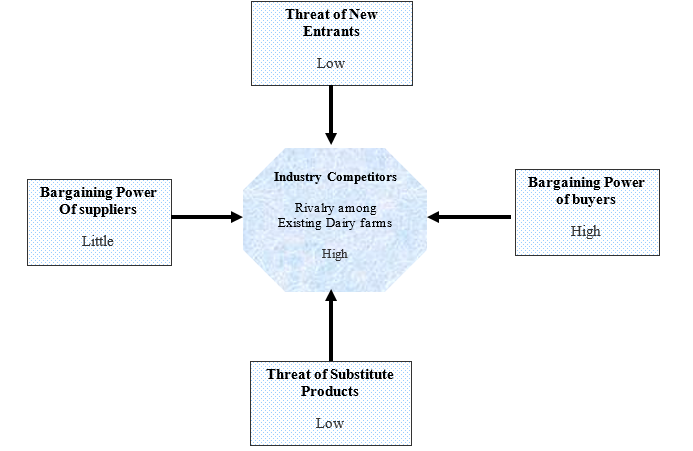
Threats of Substitutes
There are no real substitutes of the dairy industry as animal protein is unique and difficult to imitate. Though products like soft drinks and coffees can act as a substitute for fruit drinks, milk, Laban, yogurt, cheese, ghee, card, and butter have no substitutes; this makes the dairy industry unique in this respect among all other UAE industries. In the whole world, the dairy products are unique as they contain natural protein and other ingredients that no other products can directly substitute.
Rivalry among Competitors
In the dairy industry, the intense competition among the various firms is apparent. Company likes Al Rawabi, Al Ain Dairy, Al Marai, Digdaga, Fujairah, Marmum, Nadec, Al Marouj, and Al Wadi compete with each other for increasing their market share in the Gulf area. Besides these UAE companies, there are multinational businesses like Nestle, Adirondack Cheese Co Inc, and Aurora Organic Dairy, which also compete in the dairy industry.
The government of the UAE tries to protect the interests of local companies, because the latter are at a disadvantage in respect of higher production costs as compared to foreign companies. Due to the unfavourable climate of the UAE, local companies spend considerable funds to compete in the market. In this industry, the economics of scale is very important for fair competition as higher production capacities allow the companies to reduce their product prices.
Value Chain of Al-Rawabi
In the value chain of the Al-Rawabi there is a firm that produces milk and various milk products like Laban and yogurt. Currently, the company has more than 5,000 cows in its farms. Thus, there are three broad areas in Al-Rawabi’s value chain. In every area, there are series of activities, while all of them are aimed at creating business value to the company’s production process.
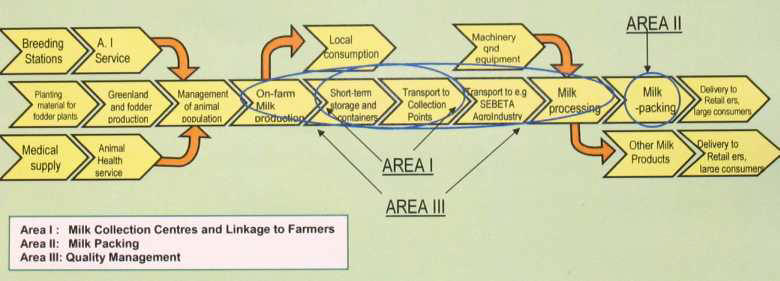
Milk Collection
The very starting stage of the value chain is collecting of milk from the farms. This also requires such supporting activities as preparing the animals for the procedure, collecting high breed animals from the suppliers, providing proper food to the animals, giving the required treatment and vaccine, washing the animals, and maintaining the optimum level of hygiene in the farm area. The proper attention to each of the listed elements, as well as the innovative equipment in the farms, allow Al Rawabi to carry out milk collection in the proper way.
During the process of collecting, the milk is stored temporarily in the farm warehouses, while the completed collection is followed by transporting the milk to the factories designed specifically for processing. Al Rawabi has numerous special transportation facilities for delivering the milk to the processing factories.
Milk Processing and Packing
When the milk comes into the processing factory, it is forwarded for further processing. At this stage, the milk is pasteurized, which allows protecting it from various damages. Next, food ingredients like vitamins and minerals are added to the milk in order to upgrade its quality. In Al Rawabi, there are different plants for preparing the pasteurised milk, yogurt, and Laban, and dessert. After this, the milk is transferred to different production facilities where other dairy products are prepared. All the products of Al Rawabi are packed in airtight plastic containers so that their quality could remain intact. The production process of Al Rawabi is designed for its every step to add considerable value to the company’s products.
Quality Control
The quality of the product is the main strength of Al Rawabi in the Gulf market. This superior quality helps the company to establish and support its position as a market leader in the dairy industry. Al Rawabi maintains the high level of quality in every step of the production process; it also adopts the concept of total quality management integrated in its developmental strategy. The company received Codex Alimentarius Commission Certificates for maintaining high quality in production process, raw materials, and finished products.
The concept of total quality management refers to the maintenance of quality in every functional aspect of the firm from production to marketing and finance. In Al Rawabi, the high quality of every aspect of production, as well as functions of the other departments, has been maintained through benchmarking. The supply of the finished products to the retail outlets is also included in this phase, and Al Rawabi supplies its products to more than 40,000 outlets in the whole Gulf region.
SWOT Analysis of Al Rawabi
Strengths
- Al Rawabi was the first gulf company to offer packed dairy food products in the UAE in other countries of the Middle East. Due tot his, it has become the market leader in the dairy food industry. The unique strength of the company is the high quality of its dairy products and their good packing;
- The company received several local and international recognitions including Codex Alimentarius Commission Certificates, Environment Management System Certificate, EN-ISO 14001, and Quality Management System Certificate;
- Currently, Al Rawabi is the leader of the UAE and Oman dairy food market that serves more than forty hundred outlets around the Gulf region. The products of Al Rawabi are currently available also in Kuwait and Iran, while the plan for the next few years is for Al Rawabi to expand to more countries (Mostafa, Darwish, & Yousef 7);
- One of the major strengths of Al Rawabi is its properly developed product distribution network and 300 hundred strong merchandise and sales teams that operate in 150 locations across UAE;
- The well-trained and technically empowered sales representatives constitute the unique resource of the company, as they are capable of facing any situation in the market during the distribution process;
- Al Rawabi has a strong customer base that manifests the company’s potential for attaining the customer loyalty in the market. The farm of the Al Rawabi, situated in Al Khawaneej, is HACCP certified for its high quality environment and strong supervision of the cattle management.
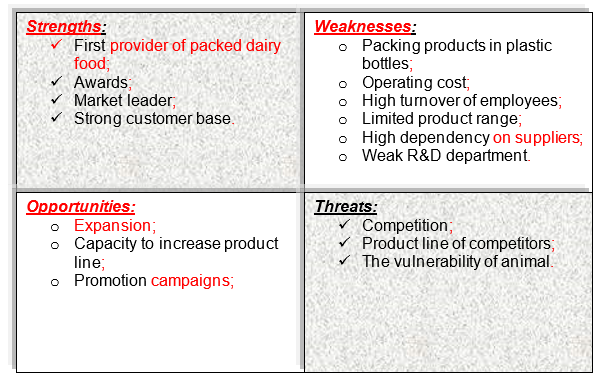
Weaknesses
- The weakness of Rawabi is their packing, which involves plastic bottles strongly rejected by the environmentalists around the world. Currently, the company introduces new bottle for its milk products, but it is very inconvenient for holding and therefore is rejected by customers;
- The production and operating cost of the company is very high, which ultimately affects the price of its product. This high price often puts the company at a competitive disadvantage;
- Another weakness of the company is its management and employees, whose turnover is very high and the management is not that much strong to tackle the situation;
- The company focuses only on limited existing products and there is no product development strategy;
- The R&D department is weak and seemingly unable to introduce new products to the market;
- The company also has a high dependency on the marketing and sales departments in its growth and development initiatives.
Opportunities
- Al Rawabi has a huge opportunity for growth and development in the existing market as well as in new markets. Though Al Rawabi is the market leader in the industry, there is an enormous scope to increase net-profit by expanding the company’s operations in new markets. Apart from the existing markets, there is a wide variety of markets for Al Rawabi to develop in including the whole Gulf region. Besides, the company has the opportunity to enter into the markets of Europe, America, and South Asia;
- Al Rawabi is represented in the market by a very limited number of product lines, and the company can use diversification to solve the issue. The production capacity of the company is not fully utilized, and there is a potential for developing the economy of scale;
- The company can use the extensive marketing and promotion campaigns to inform its customers about new products to increase their sales. Al Rawabi can collaborate with world food market’s leaders to expand through mergers or acquisitions.
Threats
- The competitors are the main threat for Al Rawabi in the market as there are some big local and multinational companies, like Al Ain Dairy and Nestle, that offer similar products;
- The competitors provide high quality products with low prices, which may reduce the demand for the products of Al Rawabi;
- Environmentalists protests against the packing used by Al Rawabi;
- The vulnerability of the animals is another threat for Al Rawabi; any time, cows may affected by the various diseases, which will cause huge losses for the company.
Generic Strategies
The generic strategy proposed by Michael Porter focuses on two aspects of trade that are based on the narrow and broader markets. According to this strategy, a company may concentrate on lowering costs or may differentiate the product line to capture the market. The target market of the company may differ from narrow to broader industry market.
In case of Al Rawabi, it mainly focuses on the product differentiation through extended high quality product lines. The company presents a unique assortment that includes the dairy products like milk, Laban, dessert, and yogurt (Al Rawabi 2010). From production to marketing of goods, the company maintains high quality of its products. Thus, the price of the product grows and, as a result, it is not possible for the company to enjoy the cost leadership in the market.
The production costs of dairy product in UAE are much higher than any other region of the world due to the unfavourable natural conditions. Most of the competitors in the market have had little extension of product line over the recent years and only concentrated on milk and chocolate.
On the other hand, Al Rawabi has a long range of products including milk, Laban, dessert, yogurts, and fresh juice of fruits as the examples of the differentiation the company works on. The company concentrates on the big market, i. e. pursues the leadership in the industry. Al Rawabi captures the market through the differentiation strategy and the unique feature of its products.
Milk
Al Rawabi has a wide range of milk products with various features, whereas the competitors offer only single featured milk. Within the pasteurized milk sector, Al Rawabi offers full cream milk, double cream milk, low fat milk, and skimmed milk.
Every individual category has its unique features and serves the demand of customers from different age groups. Suppose that for young people full cream and double full cream milk are associated with health and low fat and skimmed milk is designed especially for people over forty:
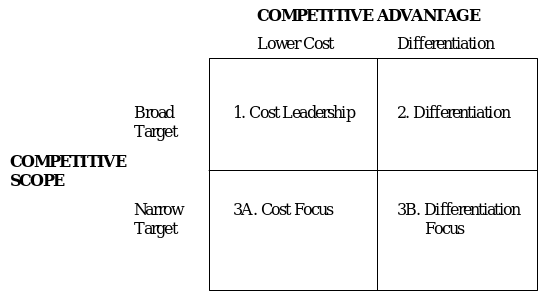
- Flavoured Milk: Al Rawabi offers milk with different flavours to its customers; the assortment includes strawberry milk, chocolate milk, and date milk. The western people might like to purchase strawberry milk, children and younger adults might prefer chocolate milk, and Arabic people fair to their customs might choose date milk;
- Yogurt: Al Rawabi offers the high quality yogurt with different features, including Robivia full fat yogurt, Robivia low fat yogurt, and flavoured yogurt. These products also address different age groups by their (suppose that high fats are for young people and low fats are for adults);
- Laban: Laban is a unique product of Al Rawabi; any multinational company in UAE does not offer it. Therefore, this product itself is a differential product which suggests some exclusive features like Robivia high fat, Robivia low fat, Rawabi up Laban, and cucumber mint Laban that separately serve the purposes of different customers;
- Health Drink: Al Rawabi introduces a wide range of natural drinks that are very helpful for maintaining good health. These drinks include B-Active Conjugated Linolic Acid, B-Activ Plant Sterol Esters, B-Activ Mango with Dietary Fibres, B-Activ Nutree Boots Orange, B-Activ Peach with Dietary Fibes, Stirred Yogurt with Aloe Vera, B-Activ Fruits of Forest with Dietary Fibres, B-Activ Nutree Boots Strawberry, Stirred Yogurt with Green Tea, and Stirred Yogurt with Berries. All these products are extremely helpful for body fitness as they include various vitamins;
- Fresh Juice: Besides the dairy products, Al Rawabi produces the fresh juice from different fruits. The product line of fresh juice includes orange, apple, mango, red orange, red grape, orange carrot, fruit cocktail, berry cocktail, lemonade, tapioca mango punch, tapioca citrus punch, tapioca island punch, strawberry, and guava juice types. They provide unique features of natural flavour and ingredients that conscious customers prefer.
- Desserts: Unlike other dairy companies, Al Rawabi brings dessert items that may serve after-meal purposes in the household or during a party. The dessert items include Cream Caramel, Milk Rice, etc. Al Rawabi’s competitors do not produce any similar products, and the customers like Al Rawabi’s offers for their unique taste and good quality.
Grand Strategies
In the following grand strategy matrix, there are four quadrants each depicting a strategy that an organisation might follow in case of necessity. The analysis shows that Al Rawabi follows the strategies of the first and the fourth quadrant that allow having strong competitive positions in the market. At the same time, Al Rawabi only observes its competitors use the strategies from the second and the third quadrants, i. e. the strategies that put those companies in a weak competitive position in the market.
Again, the organisations that fall in the first two quadrants enjoy rapid market growth, while organisations in the last two quadrants suffer from market recessions. Not all these strategies in each quadrant may be applicable to each organisation. At the same time, organisations might follow strategies falling in more than one quadrant of the following analysis:
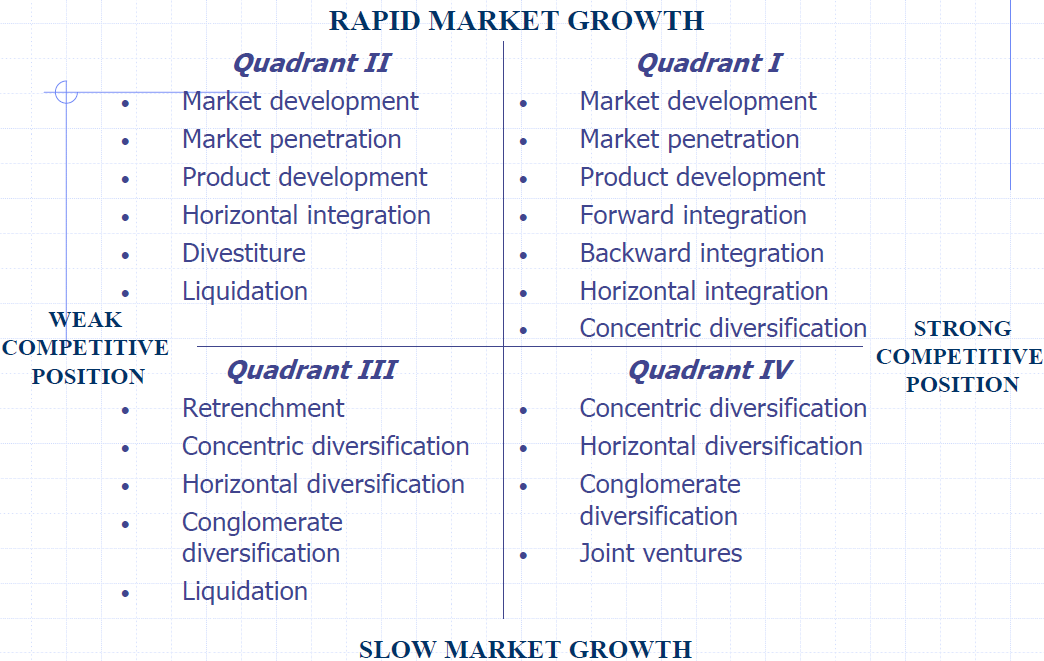
Al Rawabi is a unique organisation that has a strong competitive position in the market and enjoys leadership in the dairy product industry. In the grand matrix, Al Rawabi falls in the first quadrant, which means that the company has a strong competitive position in the market as well as the rapid market growth.
Competitive Position
Al Rawabi established itself as a strong competitor in the dairy industry. As a result, it has a large market share that allows the company to take the industry leading position. The unique product line and large market coverage within the whole Gulf region has turned the company into one of the first preferences for the local customers. In addition, Al Rawabi offers a wide range of products with best quality, which allows the company to achieve the customer loyalty in the market. It serves more than 40,000 outlets in the Gulf region through 300 competent sales teams along with 150 locations and routes.
The superior quality and availability of the product are the main competitive advantages of the company. The aim of Al Rawabi is to deliver the best quality products with natural freshness and to offer acceptable prices for its product or services (Al Rawabi 2010). The company is the first producer of packaged dairy products in the industry. It makes no compromises in the packing, though there are some controversies ‘regarding this issue. The packing of Al Rawabi’s products is allows their natural freshness remain intact before the consumption by the customers. These unique resources allow the company to compete with the local and foreign businesses and aim at the leading position in global market:
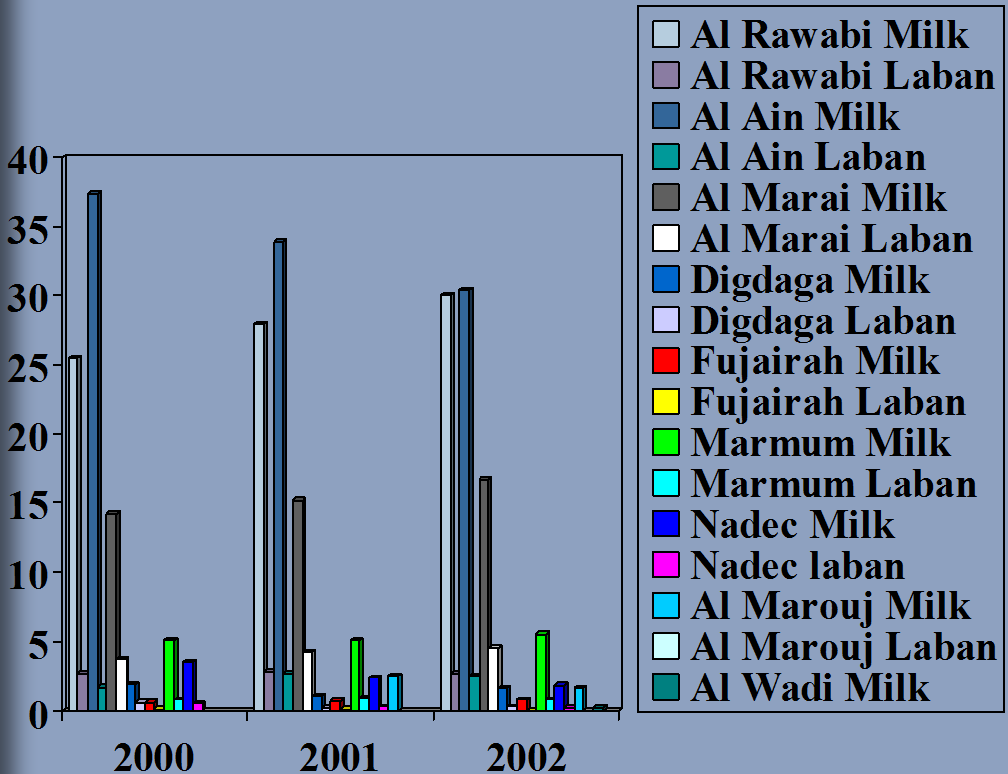
Rapid Market Growth
Al Rawabi experiences the rapid market growth, which allows the company to enjoy the leading position in the market in ten years since its establishment. The company started its business from the local market of Dubai in UAE but, within a short period, it expanded to whole UAE and obtained the leading market position through its superior product quality and customer loyalty.
The increased revenue motivated this company to expand its business to overseas markets; as a result, it started operating in Oman and Kuwait. Thus, the currently favourable market positions allow Al Rawabi to hope for extending its product line and apply diversification ideas to it. In addition, Al Rawabi has recently introduced the plastic-packed fresh fruit juice:
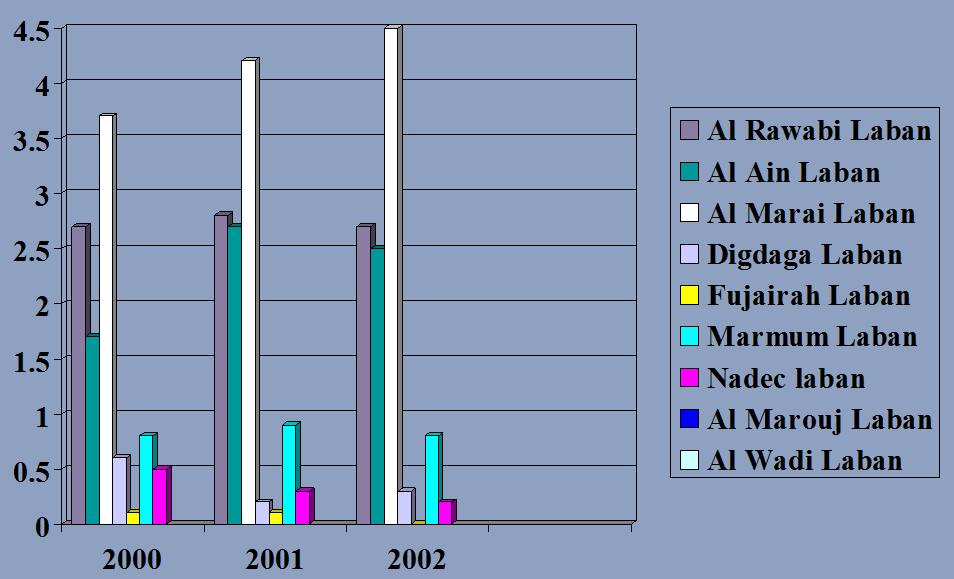
Al Rawabi currently plans to extend its market not only in the Gulf area but also outside the Middle East, in Europe and America. The company has the huge capacity to expand as it disposes of numerous farms and more than 5,000 high breed cows in them. The supply chain with the wide range of products helps the company to expand to the new sectors of the world market. Al Rawabi has the option to use various entry modes like acquisition and/or merger to penetrate the different markets in GCC and rest of the world.
Strategic Objectives
Strategic objectives refer to the means of achieving the mission of the company, i. e. the highest goal in its development. A mission statement is the explanation of the reasons of the existence of the company mostly targeted on making profits and serving the customers. The strategic objectives of the organisation set in a way so that they could be measurable, specific, timely, and appropriate (Dess, Dallas, and Marilyn 87).
The mission of the Al Rawabi is providing high quality, cost effective dairy products to its customers through using the best business practices, high-quality customer services, employee empowerment, and the most updated technology. Al Rawabi establishes the following set of its strategic objectives to achieve the mission of the company:
- High Quality Products: Al Rawabi offers high quality dairy products in the market and it helps the company to lead the UAE and Oman dairy markets. From milk collection to the distribution in the retail outlets, this company never compromises the quality and, as a result, it has obtained the certificate of ISO for the high product quality. In the farm level, the company aims at maximizing the importance of safety and hygiene factors in respect of the floor and animals, so that there is no viral or bacterial infection in the raw materials. In packing, the company uses high quality plastic and other materials for ensuring the maximum safety of the product;
- Cost Effectiveness: Al Rawabi uses the cost effective strategies through maximizing the capacity of its production. Moreover, it has big farms and production plants for high-volume production that ensures cost effectiveness of the whole process. In order to offer competitive prices, Al Rawabi selects the suppliers who have the capacity to provide the high quality materials at relatively low prices;
- Customer Satisfaction: Customer satisfaction largely depends on the quality of the products, and Al Rawabi ensures it through satisfying the customers’ quality demands. Besides, the company frequently receives feedbacks from the customers and values them as means of improving the quality of its products;
- Employee Empowerment: Al Rawabi empowers its employees through giving extensive training in order to develop strong sales teams with high technical competence. These sales teams can solve any problem regarding the sales and distribution and even the technical problems. Besides, Al Rawabi decentralizes the operation and decision making to empower the employees;
- Use of Technology: Technology is very important for any production firm, and adoption of new technologies increases the level of fixed cost and help to raise the productivity and effectiveness of the company. Al Rawabi uses the latest technology not only in their production plants but also in the farms in order to maintain the temperatures and humidity of the place. The natural conditions of the UAE are not suitable for dairy production, so the Al Rawabi invests considerable funds into technological development to produce high quality food products.
Yardstick of Strategic objectives of Al Rawabi
In this section, the strategic objectives of the Al Rawabi are measured through the following qualities:
- Measurable: Al Rawabi developed certain yardsticks for measuring the progress of the organisation towards the fulfilment of its strategic objectives. Financial performance is one of these yardsticks that reflect the financial progress of the company. The company sometimes carries out audit procedures to measure the customer satisfaction over the products it offers in the market;
- Specific: All the strategic objectives of Al Rawabi have specific massage and criteria, which must be met to achieve these objectives. Selecting the new technology for the current production plants, the company should make sure that the equipment fits the currently used units so that both are easy to adopt and adjust to each other;
- Appropriate: the strategic objectives of the Al Rawabi are appropriate for achieving the mission of the company; every strategy focuses directly on the specific issues of the mission statement. This direct and effective approach helps the company to achieve its mission for the near future;
- Realistic: The strategic objectives of Al Rawabi are realistic in a sense that the company has already achieved the bulk of its strategic objectives and concentrates now on their further development. The strategic objectives of the company are organised on the basis of the company’s actual capacities and powers;
- Timely: There is a specific period for achieving the strategic objectives of the company, and it amounts to five years. Al Rawabi plans to achieve its objectives within this five-year period, and the organisational capacities and resources allow developing such plans. The company has the financial capability and required workforce to reach these objectives within the defined timeframe.
Implementation and Control
Implementation
Basically, there are five major approaches to the implementation of strategies undertaken by organisations, and the latter can choose one or several of those approaches. These implementation approaches include Commander, Organisational Change, Collaborative, Cultural, and Creative ones. Each of the listed approaches presents specific tactics helpful in implementing various strategies. In Commander Approach, manager determines the best strategy for the organisation and uses the power to implement it. Here, the implementation manager must keep the updated information about the strategies and environment in order for the company to succeed.
Organisational Change focuses on implementing the strategies through the structural changes of the organisation and the behavioural changes in the staff relations. On the other hand, Collaborative Approach refers to the implementation of strategies through joint collaboration efforts of the organisational members, while managers act as coordinators to facilitate the organisational members’ performance. Cultural Approach applies the process of involving lower level workers in decision-making and implementation procedures. Finally, Creative Approach formulates and implements the strategies at the same time, and organizational groups receive freedom to formulate and implement the strategies.
The management team of Al Rawabi has mainly used two approaches when implementing the strategies for further development. Firstly, they have used the Collaborative Approach in implementing the corporate level strategies. According to this approach, the managers of the company give the responsibility over the functional level executives to implement strategies properly. The team members received the information regarding the strategy and then implemented the strategies with the help of the managers. In dealing with the customers and retail outlets, the sales teams had the freedom to implement the strategies regarding the customer care and supply chain.
Al Rawabi has used Cultural Approach for implementing the functional level strategies that are applied in the farm level. The workers have had the authority to implement the strategies regarding their care of the animals and controlling temperature. The workers are well trained for making decisions of implementation; accordingly, this approach contributes to upholding the quality of the raw materials.
Controlling
Al Rawabi has strong management teams to evaluate the progress in implementation of the strategies continuously. They follow three following steps to control the process:
- Monitoring Performance: The controlling team always monitors the progress of the corporate strategy implementation process. The supervisors also monitor the performance of the workers and suppliers of the company. There is the performance appraisal unit in HR department of Al Rawabi that evaluates the performance of the executives and workers on strategy implementation; high performer gets bonuses and other benefits;
- Compare the Performance: In Al Rawabi’s strategy implementation process, the management sets the benchmark for every department and for every strategy. The executives and workers must perform according to their standard; otherwise, they will not get the bonuses;
- Corrective Action: During the implementation of the strategies, any discrepancy observed by the supervisor and monitoring team causes the immediate corrective action aimed at re-directing the approach to the implementation in a right way.
Recommendation
Al Rawabi faces considerable problems, and the following recommendations are expected to help improving its market position:
- Al Rawabi should reduce the product price by implementing cost effective strategy in production and distribution segments;
- As dairy products are good for children, it should develop IMC campaign to inform people about food value of its products;
- Al Rawabi should increase the collaboration with the government to export the product to foreign markets;
- The company should use sophisticated technology for longer preservation of the products;
- It should develop a team to train the dairy farmers and other employees in the areas of highly productive breeds and treatment of animals;
- To enter the foreign markets, Al Rawabi can use one of the various entry modes (for example it can merger with large companies);
- The company should implement the high breeding technology in the farm to increase production cost effectiveness;
- It should design a e-commerce site to develop supply chain management and online purchasing system;
- It should increase budget for advertising to increase sales of dairy products;
- Al Rawabi should undertake stronger strategies for future development and try to reduce labour cost by recruiting worker south Asian worker (Bangladeshi, Indian, and Pakistani workers);
- Finally, Al Rawabi should build a strong R&D department to get appropriate information about the market environment.
Conclusion
This paper has identified the key problems of Al Rawabi Company. These include the rules that discourage further investment, high prices of the products, environmental barriers, lack of training for the dairy farmers, risk of animal diseases, high operating costs, market competition, etc. At the same time, this report has provided certain suggestions for Al Rawabi Company to take adequate measures and overcome the major challenges it faces in the market. This report has also pointed out the major strengths of the company including its resources, packing, reputation, market extension, leadership, experience, and loyal customers.
All the strategies of Al Rawabi focus on the client orientation to achieve the customer loyalty through good quality. Thus, to generate more profit from the net sales Al Rawabi should develop high breeds, carry out campaigns for private investments, create public interest in the processing segment, maintain corporate social responsibility, advertise to inform people about nutrition and use of dairy products in it, and implement the correct strategic plan as it stands on the threshold of an immense opportunity for the development of a huge competitive advantage in both local UAE and global markets.
Works Cited
Al Rawabi. Company Overview of Al Rawabi. 2010. Web.
Dess, Gregory. Dallas Lumpkin, & Marilyn Taylor. Strategic Management. New York: McGraw-Hill Irwin, 2005. Print.
Drucker, Peter. Strategy analysis and Choice. 2010. Web.
Hill, Charles, & Gareth Jones. Theory of Strategic Management. South-Wesstern: Cengage Learning, 2009. Print.
Mostafa, Golam, Darwish Al Moharby & Yousef Al Busaidi. Oman National Dairy Products: The Rise and Fall of a well-known company from the Arabian Gulf. 2010. Web.
Porter, Michael. Competitive Advantage. Export Edition. New York: The Free Press, 1985. Print.
SNV. Value Chain – Milk and Milk Products. 2010. Web.
Tigani, Ahmed, Abdel Rahim. Al Rawabi Dairy LLC- 2009. 2009. Web.
